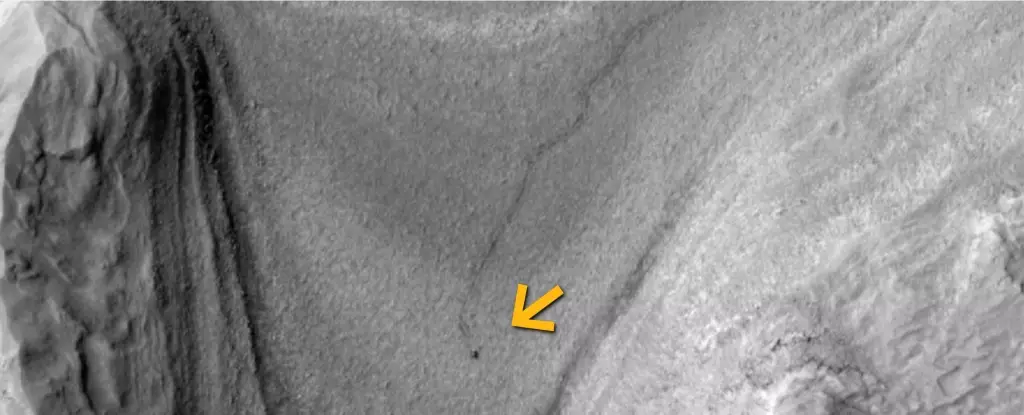Since its arrival on Mars in August 2012, the Curiosity rover has played an indispensable role in unraveling the mysteries of our neighboring planet. Nestled in the Gale Crater, this solitary robot has become a symbol of scientific inquiry, revealing secrets about Mars’ geological and hydrological history. The mission is not merely about exploring an inhospitable landscape; it represents a bold step in humanity’s quest to understand the universe and our place within it. Curiosity’s journey beckons not only scientists and researchers but also the imagination of all who gaze upward at the stars and wonder what lies beyond.
The Lonely Adventurer
An image captured by NASA’s Mars Reconnaissance Orbiter poignantly depicts Curiosity as a mere speck on an alien landscape, emphasizing its isolation on a world that is both haunting and captivating. In this stark photo, the sun’s rays illuminate the reddish expanse of Martian sands, with a thin, winding track trailing behind—evidence of Curiosity’s slow but steady progress. The rover’s journey, spanning 320 meters across eleven drives, is a testament to the tireless effort behind interplanetary exploration, even if the distance pales in comparison to human capabilities. It’s ironic; in a universe of immense scale and potential, Curiosity’s movement is deliberately sluggish—a proxy for our own tentative steps into the unknown.
Engineering Constraints and Discoveries
The slow pace of Curiosity is dictated by multiple factors, primarily its need for energy conservation and navigation safety. Powered by a 110-watt nuclear generator, the rover’s operational efficiency is paramount. Its methodical journey allows scientists to gather valuable data while ensuring that the robot’s complicated machinery remains intact amidst the unforgiving landscape. As Curiosity traverses geological features, each rock layer and soil sample it analyzes serves as a clue in piecing together Mars’ complex history—specifically, the presence of water and potential for microbial life. In February 2023, Curiosity ventured along the Gediz Vallis channel, where traces of ancient water flow paint a compelling narrative about a potentially life-supporting environment that once existed on the Martian surface.
Unknowns of the Red Planet
Curiosity’s quest has also led to unexpected findings, such as discovering a cache of pure sulfur, the implications of which remain to be fully understood. Such discoveries highlight the inherent unpredictability of exploring new frontiers. With the rover now shifting focus to intriguing geological formations, including the boxwork patterns at the base of Mount Sharp, the scientific community is abuzz with anticipation. These structures—formed over eons through the flow of groundwater—could reveal vital evidence of Mars’ wet past, a condition previously deemed conducive to microbial life. As Curiosity facilitates the search for past biosignatures, it underscores how each feature on Mars could provide insights that resonate far beyond its dusty surface.
The Broader Implications of Curiosity’s Mission
The success and perseverance of Curiosity embody the resilience of the human spirit. This solitary robot is not just a marvel of engineering; it is a beacon of hope and determination. The journey of Curiosity mirrors humanity’s own exploration of the unknown—persevering against challenges and setbacks, driven by an insatiable curiosity. As we send more rovers and missions to explore distant worlds, Curiosity stands as a testament to what can be achieved when innovation is paired with curiosity.
As we ponder the significance of this robotic explorer, one cannot ignore the emotional connection that it evokes. Curiosity has become an extension of ourselves—a resilient traveler uncovering the secrets of a planet that, while lifeless now, once held the potential for life. While its tracks may soon fade, the insights gleaned from its mission have the potential to endure, pushing the boundaries of our knowledge and understanding of life beyond Earth. In the grand tapestry of exploration, Curiosity is both a thread and a flame, illuminating our path to the stars.

